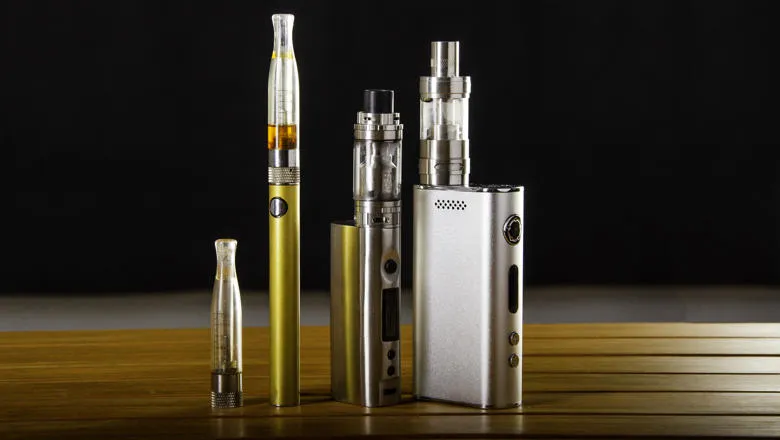Vaping and smoking among young people in England have plateaued over recent years. Most vapers had tried smoking but many continued to smoke alongside vaping. Emphasising the relative risks of the two products could therefore help to reduce smoking in youth.
Mr Erikas Simonavičius, from the Institute of Psychiatry, Psychology & Neuroscience (IoPPN), King's College London
23 February 2021
Evidence strengthens that vaping is effective for stopping smoking but not reaching its full potential with adult smokers
Smoking remains the largest single risk factor for death and years of life lived in ill-health and is a leading cause of health inequalities in England.

The government has outlined an ambition to go smokefree by 2030 and alternative nicotine delivery devices, such as nicotine vaping products, could play a crucial role in achieving this goal. A report from researchers at King’s College London, published today, covers the latest evidence on prevalence and characteristics of nicotine vaping product use in England and updates the evidence on the impact of vaping on smoking cessation.
Young people, smoking and vaping
Smoking and vaping prevalence among young people in England in 2020 stayed the same as in 2019 with 6.7% of 11- to 18-year-olds smoking sometimes or once a week (compared with 6.3% in 2019) and 4.8% vaping at least monthly in both years. As in previous years, most young people who try vaping also try smoking with only around 1% of current 11- to 18-year-old vapers having never tried smoking. Fruit flavours were the most popular amongst current vapers followed by menthol/mint. Less than half (43.3%) of 11 to 18 years olds thought that vaping was less harmful than smoking, compared with two-thirds in 2016.
Three-quarters of underage vapers bought vaping products from friends, shops or on the internet, signalling that enforcement of age of sale regulations for these products, as well as tobacco cigarettes, needs to be improved.
A fifth (18.4%) of 11- to 18-year-old vapers reported experiencing urges to vape almost all the time or all the time and just over a third (36.5%) said that they did not feel any urges to vape at all. These figures highlight the need for more research on the addictiveness of different types and strengths of nicotine vaping products among young people.
He added, “However, a significant minority of 11- to 18-year-old vapers were reporting urges to vape so more efforts are needed to prevent underage sales of vaping, as well as smoking, products to young people in England.”
Adults, smoking and vaping
Smoking among adults in England continues to fall - approximately 15% in 2020 depending on the survey - around 6 to 7 million smokers. Vaping among adults has remained stable at around 2.7 million (around 6% of all adults). The vast majority of vapers (well over 90%) currently smoke or used to smoke, with the proportion of vapers who also smoked declining over time. The most common reasons for vaping were to stop or reduce smoking. Fruit, tobacco and menthol/mint nicotine vaping products were the most popular flavours and most vapers used refillable tank devices. The proportion of current vapers who had vaped for more than three years has grown in recent years to 39% in 2020. In adults, smoking and vaping is higher among more disadvantaged groups in society.
Perceptions about the relative harms of smoking and vaping among adult smokers are increasingly out of line with the evidence. Among adult smokers, only 29% believed vaping was less harmful than smoking, while 38% thought they were equally harmful and another 15% believed vaping to be more harmful than smoking.
We know that more than half of all long-term smokers will die early because of smoking. But in England, seven out of ten adult smokers (70.8%) think vaping is at least as harmful as smoking or are unsure.
Author Dr Leonie Brose, from the IoPPN, King's College London
She continued, “Such misperceptions were even worse in smokers from more disadvantaged groups and among smokers from black and minority ethnic groups. These figures show a failure to communicate the evidence to those affected by the harms of smoking.
“We are also seeing that among adults who vape, more and more have been vaping for several years, suggesting that vaping is not reaching new people, limiting its harm reduction potential.”
Vaping helps people to stop smoking
We reviewed three data sources about the effect of vaping on smoking cessation or reduction. Taken together, they all point in the direction that vaping appears to help people stop smoking. From observational studies, we saw that vaping products have been the most popular stop smoking aid in the general population since 2013. In 2020, 27.2% of smokers who tried to quit in the previous year used a vaping product compared with 18.2% using nicotine replacement therapies and 4.4% varenicline/Champix. The research shows that vaping is positively associated with quitting smoking and it has been estimated that in 2017, 50,000 more smokers stopped who wouldn’t have stopped without vaping products. Whilst they are a popular quit aid among the general population, only 5% of quit attempts in stop smoking services include the use of a vaping product. Quit rates of 60-74% were seen among people who had used a vaping product as part of their quit attempt, 59% for varenicline, a prescription only medicine and 47% for combination nicotine replacement therapy (NRT). From systematic reviews of research studies, we found that vaping products containing nicotine were more effective than NRT, though more research is needed.
Since we last reviewed the effect of vaping on smoking cessation, the evidence has strengthened that vaping products help people stop smoking. In research studies, vaping products that contain nicotine were significantly better than licensed nicotine replacement therapies such as patches.
Dr Debbie Robson, from the IoPPN, King's College London
She added, “However more studies are needed particularly including newer types of vaping products. In stop smoking services in England recently, nicotine replacement therapies were used in ten times more quit attempts than vaping products.
Whilst people who want to quit smoking should have a wide choice of quitting aids available to them, in England, vaping products have helped many thousands of people quit and there is the potential to help thousands more if they were more widely accessible in stop smoking services.”
The Government wants England to be smokefree in 10 years’ time. Such a goal is commendable, but there is a long way to go particularly for people from disadvantaged groups. E-cigarettes have a role to play but to optimise their contribution, the barriers to their use by smokers need removing, and greater efforts need to be made to prevent youth access.
Professor Ann McNeill, from the IoPPN, King's College London
Professor Ann McNeill and colleagues from the Nicotine Research Group at King's College London present ‘Vaping in England: an evidence review 2021’
McNeill, A., Brose, L.S., Calder, R., Simonavicius, E. and Robson, D. (2021). Vaping in England: An evidence update including vaping for smoking cessation, February 2021: a report commissioned by Public Health England. London: Public Health England
Contact
For further information please contact Louise Pratt, Head of Communications, Institute of Psychiatry, Psychology & Neuroscience, King’s College London louise.a.pratt@kcl.ac.uk / +44 7850 919020




